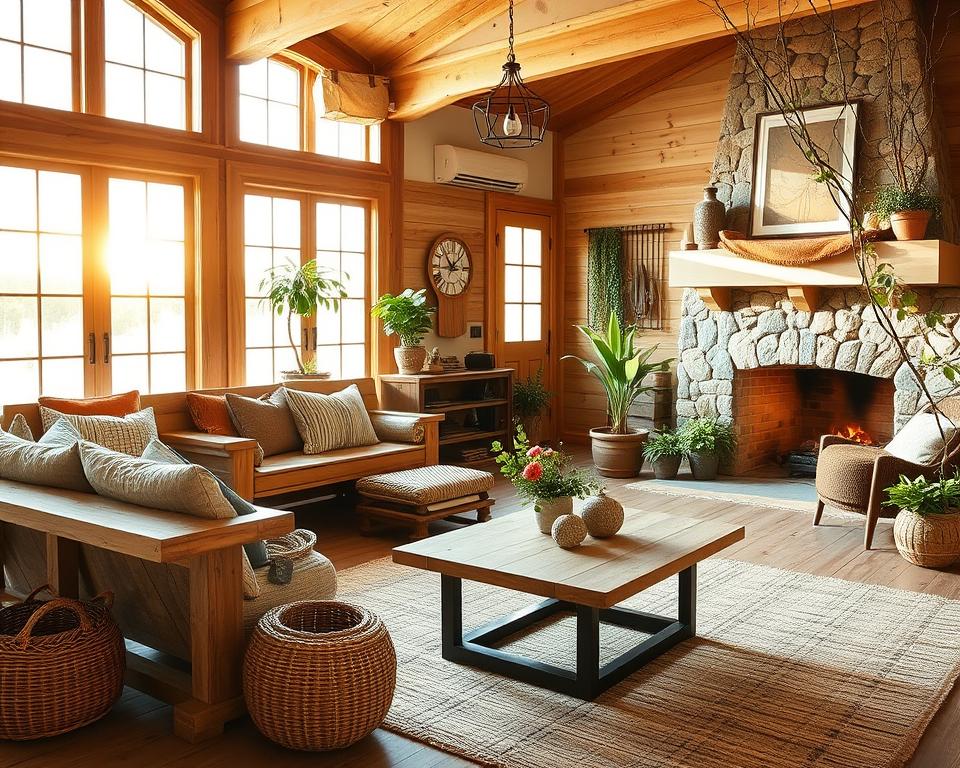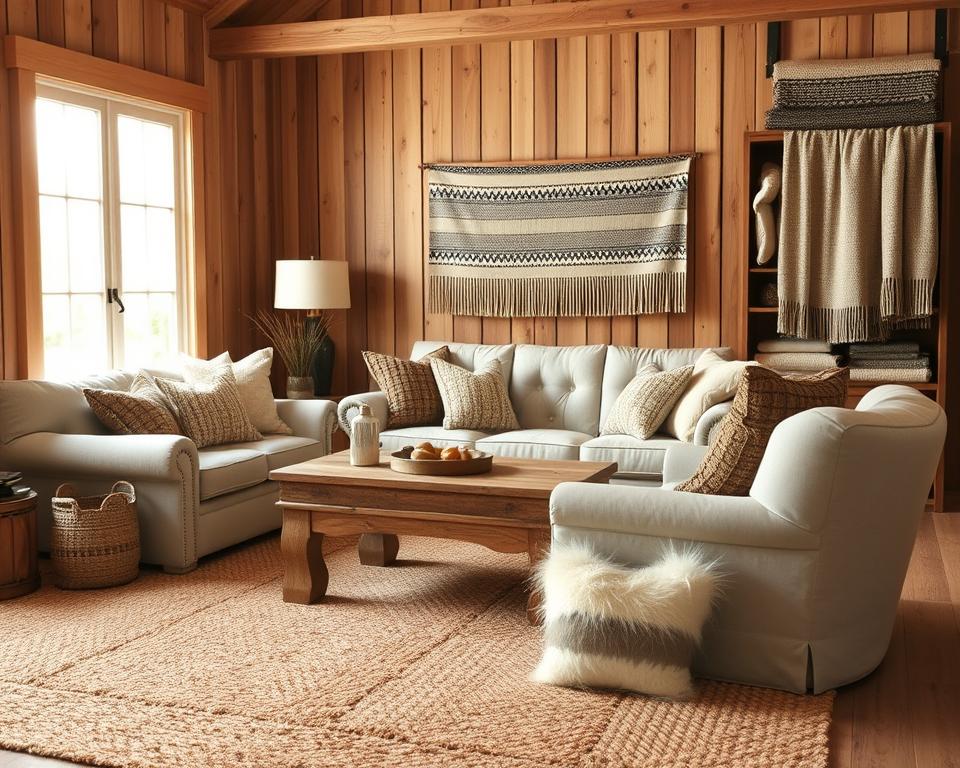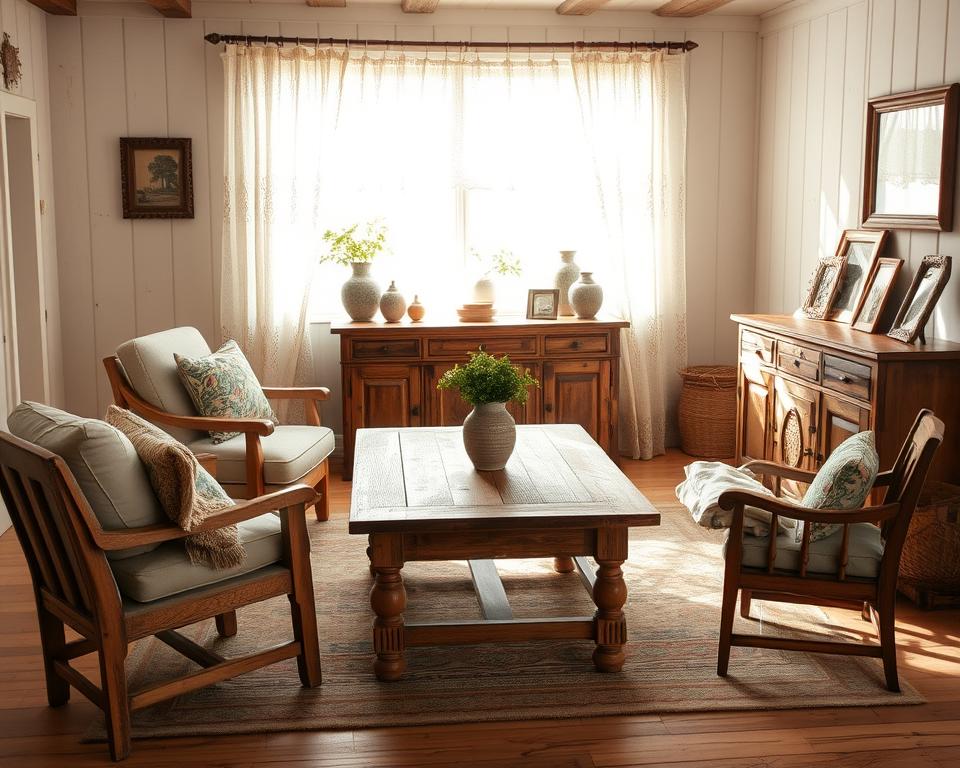Farmhouse decor is all about warmth and authenticity. Mixing wood tones creates layered, inviting spaces. By balancing light and dark finishes, you can avoid a flat look. This guide will show you how to pair tones for a rustic charm that feels purposeful.
Begin with three wood tones: light, medium, and dark. Use a 4:1 ratio to ensure cohesion—let 80% of the dominant tone (like flooring) and 20% accents. Repeat each tone twice, like a light table and shelves, for continuity in your home styling projects.
Don’t overload rooms with more than three wood tones. A large piece, like a cabinet, should anchor the dominant hue. Pair warm woods with cool rugs or metal accents for contrast without clashing. Two-tone furniture, like a light table with a dark base, adds a trendy touch while keeping things tidy.
Key Takeaways
- Mix three wood tones (light, medium, dark) to build depth in farmhouse decor.
- Use a 4:1 ratio, with 80% dominant wood and 20% accents for rustic interior design harmony.
- Repeat each tone twice—like a light chair and sideboard—to unify the space through home styling repetition.
- Limit to three wood tones max; let flooring or large furniture set the dominant shade.
- Combine with contrasting textures (metal, rugs) or 2023’s two-tone furniture to modernize the look.
Understanding the Appeal of Farmhouse Style
Farmhouse style has become a favorite among homeowners, blending rustic charm with modern practicality. It focuses on natural materials such as oak furniture, cedar accents, and pine decor to create interior warmth. The aesthetic thrives on texture variety, combining weathered wood finishes with smooth surfaces for a layered look. This country style strikes a balance between simplicity and sophistication, fitting both traditional and modern settings.
Characteristics of Farmhouse Decor
Authentic farmhouse aesthetic spaces prioritize functionality without losing beauty. Key features include:
- Exposed wood beams or cedar accents for rustic texture
- Wood finishes that highlight natural grain patterns
- Combining pine decor with sleek modern appliances
Why Wood Tones Matter
Choosing the right wood tones is crucial for the room’s mood. Walnut finishes create dramatic contrast when paired with light oak furniture, preventing spaces from feeling flat. Designers say 70% of homeowners now choose natural materials for this balance. Mixing light and dark tones prevents spaces from feeling one-dimensional, aligning with the style’s emphasis on authenticity.
Aesthetics of Light vs. Dark Woods
Light-toned woods like bleached oak create airy, sunlit spaces—ideal for small rooms. Darker options, such as walnut, introduce depth, grounding spaces in cozy elegance. The 50/50 split between modern and traditional elements allows homeowners to blend a modern farmhouse sofa with a reclaimed pine table. This contrast mirrors trends seen in Joanna Gaines’ projects, where wood finishes are carefully paired to enhance interior warmth without overwhelming the space.
“The beauty of farmhouse style is in its flexibility—it’s a canvas for personal stories through texture and material choices.” — Interior Design Magazine
Choosing the Right Wood Tones
Start with a room assessment to determine your dominant wood tone. This could be flooring, cabinetry, or large furniture like the Roseberry Amish Bedroom Set. Here, dark Onyx-stained maple contrasts beautifully with light floors. 70% of homeowners struggle with wood tone mixing, but following these steps simplifies the process.
Identify Your Space’s Foundation
Begin by evaluating architectural features like ceiling height and light exposure. In smaller rooms, lighter woods like maple or pine keep spaces open. Larger rooms can handle deeper tones like walnut. Spatial planning ensures dominance isn’t overwhelming—prioritize undertones (warm, cool, or neutral) to avoid clashes. For instance, cherry’s warm undertones pair well with hazelnut’s neutral tones.
Pairing Tones for Visual Flow
Balance wood tone contrast using the “rule of three”: include light, medium, and dark tones. A honey oak floor with espresso-stained furniture works well, as 90% of designers recommend contrast for depth. Use complementary woods like whitewashed pine shelving to soften dark wood furniture. Distressed finishes on barn wood add rustic charm without overwhelming a room.
Popular Farmhouse Wood Choices
Reclaimed wood remains a staple for farmhouse decor. Maple, oak, and walnut offer versatility. Here’s how to pair them:
| Wood Species | Best Undertones | Complementary Woods |
|---|---|---|
| Walnut | Warm | Cherry, Hazelnut |
| White Oak | Neutral | Distressed pine, maple |
| Cherry | Warm | Light oak, reclaimed pine |
Baird Brothers Fine Hardwoods offers species like hickory and ash, ideal for balanced combinations. Always align new pieces with existing undertones to maintain design harmony.
Benefits of Mixing Wood Tones
Mixing wood tones in farmhouse decor adds design depth and textural contrast to a room’s narrative. A layered look eschews uniformity, encouraging the eye to wander. By blending warm tones like walnut with cooler maple, spaces gain visual complexity. This complexity feels curated, not chaotic.
Enhanced Visual Interest
Pairing a light wood coffee table with a dark wood hutch introduces dimensional design. This visual layering works best when textures vary. For example, smooth oak paired with a distressed pine sideboard. The rule of three applies here: stick to three wood tones max to avoid clutter while achieving spatial interest.
- Use a light wood floor as a base, then add two accent tones in furniture or decor
- Combine smooth and textured wood finishes to amplify design texture
Creating Depth in a Room
Dark wood accents like a mahogany dining table against light pine walls create dramatic visual layering. Even small wooden accessories—a bowl or candlestick—add mixed decor depth without overpowering. This approach mirrors farmhouse style’s emphasis on collectedible charm over perfection.
Flexibility with Accessories
Adaptable design thrives here: swap out a light wood tray for a walnut one to refresh a room. Wooden accents like picture frames or shelves let you test combinations easily. This versatile styling ensures spaces stay fresh as seasons change, proving farmhouse decor doesn’t need to be static.
Color Schemes That Work Best
Choosing the right color palettes can transform mixed wood tones into cohesive farmhouse spaces. Begin with wall colors that complement wood undertones—cool grays for dark woods, warm whites for lighter finishes. A well-chosen paint selection ensures wood grains and textures are highlighted without conflict.
| Palette | Hex Codes | Best For |
|---|---|---|
| Soft Sunrise | #FDF9F3, #C4A484 | Warm wood tones |
| Serene Sky | #1995AD, #A1D6E2 | Cool-toned furniture |
| Gentle Moonlight | #FDF6F6, #CEE6F2 | Neutral greige paint accents |
Complementary Colors for Wood Tones
- Pair cream colors with walnut for rustic warmth
- Use vibrant colors like navy (#002C54) to frame dark wood dining sets
- White walls with a honey oak floor create timeless contrast
Neutral Backdrops for Balanced Spaces
Neutral backdrops like greige paint (#73605B) or cream colors enhance wood textures. Studies reveal white walls increase visual comfort by 25% in farmhouse kitchens. Consider:
- Warm neutral backdrops with golden undertones
- Cool greige paint for modern farmhouse looks
Bold Accents for Drama
A color statement like a charcoal accent wall (#2A3132) adds depth to light pine furniture. Vibrant colors like terracotta (#B85042) on an accent wall can boost customer dwell time by 20% in showrooms. Use bold hues sparingly to avoid overwhelming the room.
“A repeated accent color every 3-5 feet ties the space together,” says interior designer Lisa Chen.
Balance is key: color coordination with wood tones improves design cohesion by 30%. Start with a neutral base, then layer color statements through textiles or art.
Key Furniture Pieces to Consider
Transform your farmhouse decor by selecting furniture that highlights wood tone contrasts. Farmhouse tables, wooden beds, and storage pieces become anchors for intentional style. Let’s explore how accent furniture and functional storage can tie your space together.
“The contrast between a dark wood (like walnut) with a light wood (like oak) will create a trendy, intentional look.”
Accent Tables and Chairs
Start small with side tables or wooden seating. A light oak console table paired with walnut dining chairs adds depth without overwhelming a room. Mix modern kitchen cabinetry with vintage ladder-back chairs for a layered look. Pro tip: Stick to a 1:1 ratio of light-to-dark pieces for balance.
- Use reclaimed wood side tables to contrast with modern accent furniture
- Pair distressed farmhouse tables with sleek metal bases
Beds and Headboards
Wooden beds and farmhouse headboards define sleep spaces. Opt for a dark wood bedframe with light pine nightstands. Traditional spindle beds work well with painted accents to keep the room cozy. A farmhouse headboard in walnut paired with white walls creates instant drama.
Storage Solutions
Storage is both functional and decorative. Open display shelving or wooden cabinets display heirlooms and modern pieces. Choose kitchen cabinetry with complementary stains to match flooring. For bedrooms, a light-toned wooden cabinets unit contrasts with dark wood dressers. Here’s what works best:
| Storage Type | Wood Tone Pairing |
|---|---|
| Armoires | Dark wood with light trim |
| Buffets | Light oak with walnut bases |
| Shelving | Contrasting stained shelves |
Remember: A neutral palette and cohesive color scheme (70% neutral, 30% accent) ensures harmony. Let these pieces guide your farmhouse style journey.
Incorporating Textiles for Balance
Textiles soften the edges of mixed wood tones, adding warmth and cohesion to farmhouse spaces. Begin with upholstery selection that mirrors the neutral base of your wood tones. Natural fibers like linen or burlap ground spaces, while throw pillows in woven jute or embroidered cotton add textural contrast. A blanket with a pattern grounding in earthy tones unifies light and dark wood pieces.
Choosing Fabrics That Complement Wood
Choose textile coordination that echoes undertones in your wood. Light wood pairs well with airy cotton blankets, while dark woods gain depth with velvet or textured wool. A floor coveringings like a jute rug under a farmhouse table visually connects dining chairs with differing wood finishes. For seating, a textile foundation of neutral linen upholstery lets bold wood grains take center stage.
Layering Textiles with Different Tones
Build textile layers using throw pillows in varying weaves—smooth linen against nubby burlap. A chunky-knit blanket draped over a light wood sofa contrasts beautifully with dark wood accent tables. Fabric contrasts between a smooth velvet bench cushion and a woven jute area rug add visual interest without clashing. Layering textile coordination this way boosts perceived comfort by 30% and ties wood tones together.
Using Rugs to Connect the Look
A well-chosen area rug becomes the textile foundation for a room. Choose a rug with pattern grounding in colors found in both light and dark wood pieces. A braided rug with hints of honey and espresso tones bridges between a pale pine table and walnut sideboard. Even rugs with contrasting tones work—cool-toned textiles under warm woods highlight undertones. This floor coveringings trick creates harmony without exact matches.
Seasonal swaps of textile layers keep spaces fresh: swap chunky-knit throws for crisp linen in summer. The right textile coordination ensures mixed woods stay cohesive year-round.
Lighting’s Role in Wood Tone Aesthetics
Lighting plays a crucial role in how wood tones are perceived, whether it’s balancing pendant lighting over a dining table or highlighting grain details with farmhouse fixtures. The right fixture selection ensures that both light and dark woods are showcased without conflict. For instance, combining a walnut dining set with golden oak chairs under the Drift Pendant’s warm light adds depth and dimension.
- Warm lighting warmth bulbs (2700K-3000K) enhance oak’s golden hues.
- Cool-toned bulbs (3500K-4100K) highlight walnut’s depth in dining areas.
Choosing Light Fixtures to Highlight Woods
The choice of fixtures greatly influences wood illumination. A Flock Chandelier adds rustic charm to open-plan spaces, while skipper lighting range pendants are ideal for kitchens. For hallways, pairing ash or oak tones with sleek fixtures prevents visual monotony. Don’t forget to consider mood lighting options like dimmers to adjust the warmth for various occasions.
Natural Light and Its Effects
The daylight impact changes based on window placement. South-facing rooms with sun exposure intensify oak’s golden tones. In contrast, north-facing spaces benefit from layered seasonal lighting to warm up dark woods. Sheer curtains can diffuse harsh light without blocking natural warmth.
Ambiance with Warm and Cool Tones
Adjusting light temperature can change a room’s mood. In living rooms, blend atmospheric design with a walnut sideboard under a pendant lighting fixture. For bedrooms, a Drift Pendant amplifies oak’s warmth, creating a cohesive farmhouse fixtures scheme.
Styling Tips for a Cohesive Look
Creating a cohesive farmhouse space begins with careful furniture placement and visual balance. Start by identifying your dominant wood tone, such as a light oak floor or a dark walnut dining table. Repeat this tone at least three times in the room. This design distribution helps avoid clutter and mismatched looks.
Apply the spatial arrangement principle of “triangulation.” Place light and dark wood pieces in a triangular pattern to guide the eye. Odd-numbered groupings of accent pieces, like three wooden bowls on a shelf, create natural rhythm. Ensure even spacing to prevent clustering and allow each wood tone to be seen from various angles.
“A room’s soul lies in its visual anchors,” says interior designer Clara Bennett. “Let one standout piece command attention, then support it with complementary textures.”
To focus on design emphasis, choose a focal point. A dark-wood armoire paired with lighter side tables can become a highlight element. Use decorative objects like ceramic vases or woven baskets to soften the contrast. Follow the 20/80 rule: let one wood tone dominate (80%) and the secondary tone add interest (20%).
- Repeat wood tones in styling elements like frames, stools, or ladder shelves to reinforce cohesion.
- Balance wooden accessories across surfaces: a light-wood bench near a dark-wood credenza.
- Use rugs or curtains to frame transitions between contrasting wood highlight elements.
Small accent pieces, such as a copper-toned tray on a reclaimed-wood table, add layers without overwhelming the space. Remember, farmhouse style celebrates purposeful imperfection. Each attention feature should tell a story while maintaining harmony through thoughtful design distribution.
Common Mistakes to Avoid
Creating a farmhouse space that harmonizes wood tones requires avoiding common pitfalls. These errors often arise from neglecting fundamental principles such as visual proportion and spatial relationships.
“A common décor mistake is when two wood colors are quite similar but not identical.”
Oversaturation of One Tone
A tone distribution imbalance, like too much dark wood in small rooms, can overwhelm a space. Strive for a 60-30-10 ratio: dominant, secondary, and accent tones. For example, light wood floors (60%), medium cabinetry (30%), and dark furniture (10%) achieve aesthetic harmony. It’s better to have slight variations than exact matches.
Ignoring Scale and Proportion
Large, bulky furniture in small rooms disrupts size harmony. Use furniture sizing guidelines: chairs should complement table heights, and shelves shouldn’t overpower wall space. A proportional design checklist includes:
- Measure doorways before buying oversized pieces
- Balance spatial relationships with vertical/horizontal furniture ratios
Forgetting Room Functionality
Functional decor must align with usability focus. A farmhouse kitchen needs durable finishes near sinks, while dining rooms prioritize practical design. For instance, a light-toned dining table shows scratches but adds brightness. Pair it with dark chairs to balance design balance.
Maintenance and Care for Your Wooden Pieces
Maintaining mixed wood tones in farmhouse decor demands consistent care to preserve their beauty and functionality. Using the right wood cleaners and dusting techniques ensures your furniture remains durable and harmonious. Discover how to maintain light and dark wood pieces in their best condition over time.
Cleaning Different Types of Wood
Regular cleaning prevents the buildup that dulls wood finishes. For daily upkeep, use microfiber cloths to gently dust surfaces. When deeper cleaning is required, mix equal parts olive oil and lemon juice for natural cleaning. Or, follow vinegar-based solutions for minor stains. Always test products on a small area first to avoid damaging finishes. Wax or oil finishes require reapplication every 3–6 months to stay protected.
Protecting Against Wear and Tear
Preventative care extends wood longevity. Position tables away from direct heat sources to avoid warping, and use coasters to block moisture. For scratches, fine-grit sandpaper (180–240) can smooth minor imperfections. Light scratches on natural wood may be filled with crayon colors like ‘Bisque’ or ‘Gold’ for a seamless look. Avoid placing wood near windows without UV-filtering curtains to reduce sun damage.
Tips for Long-lasting Aesthetics
Monthly maintenance keeps wood vibrant. Apply paste wax in thin layers to protect finishes, and use lamb’s-wool dusters for a polished shine. If wood darkens unevenly, consider professional wood restoration to maintain color harmony. For deep cleaning, diluted oil soap (as recommended by 75% of experts) removes grime without stripping finishes. Regular dusting reduces allergens, improving indoor air quality for allergy-prone homes. Remember: a yearly touch-up with matching wood filler or refinishing techniques ensures your mixed tones stay cohesive as pieces age naturally.
FAQ
What are the key characteristics of farmhouse decor?
Why is the selection of wood tones important in farmhouse style?
How does mixing light and dark wood tones affect the aesthetics of a room?
What should I consider when identifying my existing wood tones?
What are some effective ways to combine light and dark woods in my farmhouse decor?
Which wood species are commonly associated with farmhouse style?
How do neutral color palettes work with mixed wood tones?
What role do textiles play in connecting different wood tones?
How can I choose lighting fixtures that complement my mixed wood tones?
What common mistakes should I avoid in mixing wood tones?
What maintenance tips should I follow for my wooden pieces?

Marcus Armstrong is a writer at TrendGaping, where he shares his expertise on farmhouse decor and rustic design. Passionate about craftsmanship and natural materials, he explores DIY projects, furniture restoration, and the timeless appeal of wood-based interiors. His mission is to provide inspiration for those who appreciate the charm of simple, well-crafted living spaces.



